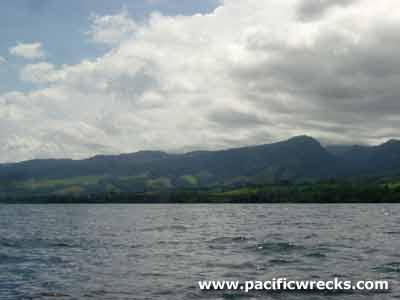|
|
|
|
| Missing In Action (MIA) | Prisoners Of War (POW) | Unexploded Ordnance (UXO) |
| Chronology | Locations | Aircraft | Ships | Submit Info | How You Can Help | Donate |
|
 Justin Taylan 2003 |
Location Lat 9° 4' 0S Long 148° 34' 0E Pongani is located at an elevation of 3' / 1m above sea level on the north coast of New Guinea. Borders Dyke Ackland Bay to the north. Pongani is roughly 10 miles from Oro Bay and 40 miles from Buna. Today located in Oro Province in Papua New Guinea (PNG). Wartime History During 1942, a rough and difficult track spanned from Natunga to Pongani known as a the Natunga-Pongani Track. On October 14, 1942 the Australian Army 2/6 Independent Company explored a trail that spanned from Wangiela diagonally across Cape Nelson and crossed the Musa River at Totore before reaching Pongani as a route for the U.S. Army soldiers marching forward to the frontline battlefields. The Australians managed to reach Pongani, but found the trail was flooded and unusable. The Pongani area was developed into a staging area for the Battle of Buna-Gona. Both American and Australian infantry units staged in Pongani bound for the north coast battlefields. Based at Pongani was the U.S. Army 32nd Infantry Division under the command of Major General Edwin E. Harding including the 126th Infantry Regiment and 128th Infantry Regiment. On October 18, 1942 two luggers including King John departed from Wanigela bound for Pongani attempting to land men and supplies at Pongani. Spotted by a B-25 Mitchell from the 3rd Bomb Group (3rd BG) off Pongani the ships were mistaken as enemy vessels then bombed and strafed. During the attack, two were killed Lt. A. B. Fahnestock, in charge of small boat operations for the COSC and Byron Darnton, a correspondent for The New York Times who served with the 32nd Division during World War I, and was to report on their operations in World War II. Several others were wounded, and one of the boats suffered severe damage that it had to be withdrawn. Pongani U.S. Army Supply Dump During late 1942, the U.S. Army 32nd Infantry Division, 128th Infantry Regiment established its supply dump at Pongani. Allied shipping would arrive at night and depart by dawn, fearing Japanese air raids. Since there was no wharf or pier, supplies were unloaded at night from barges and taken ashore using smaller boats or native canoes. Pongani Airfield Built by Americans in late October 1942 to support the Buna / Gona campaign, disused today. /43-3262.html">OA-10 Catalina 43-3262 Pilot Smith crashed October 16, 1943 discovered 1944 References U.S. Army in World War II - Victory In Papua Chapter 7 pages 106, 107-110, 116-119, 122-124 Almost A Family pages 14, 17, 51-52, 306, 308, 312, 314, 321, 324, 326-327, 329-330, 345 Contribute
Information Last Updated
|
Map Fallingrain |
| Discussion Forum | Daily Updates | Reviews | Museums | Interviews & Oral Histories |
|